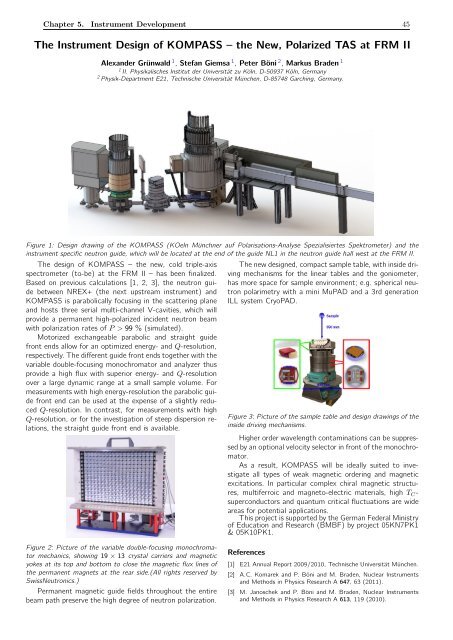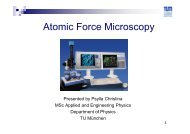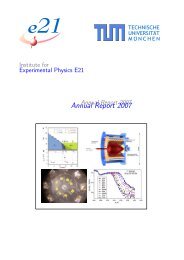Annual Report 2011 / 2012 - E21 - Technische Universität München
Annual Report 2011 / 2012 - E21 - Technische Universität München
Annual Report 2011 / 2012 - E21 - Technische Universität München
You also want an ePaper? Increase the reach of your titles
YUMPU automatically turns print PDFs into web optimized ePapers that Google loves.
Chapter 5. Instrument Development 45<br />
The Instrument Design of KOMPASS – the New, Polarized TAS at FRM II<br />
Alexander Grünwald 1 , Stefan Giemsa 1 , Peter Böni 2 , Markus Braden 1<br />
1 II. Physikalisches Institut der Universität zu Köln, D-50937 Köln, Germany<br />
2 Physik-Department <strong>E21</strong>, <strong>Technische</strong> Universität München, D-85748 Garching, Germany.<br />
Figure 1: Design drawing of the KOMPASS (KOeln Münchner auf Polarisations-Analyse Spezialisiertes Spektrometer) and the<br />
instrument specific neutron guide, which will be located at the end of the guide NL1 in the neutron guide hall west at the FRM II.<br />
The design of KOMPASS – the new, cold triple-axis<br />
spectrometer (to-be) at the FRM II – has been finalized.<br />
Based on previous calculations [1, 2, 3], the neutron guide<br />
between NREX+ (the next upstream instrument) and<br />
KOMPASS is parabolically focusing in the scattering plane<br />
and hosts three serial multi-channel V-cavities, which will<br />
provide a permanent high-polarized incident neutron beam<br />
with polarization rates of P > 99 % (simulated).<br />
Motorized exchangeable parabolic and straight guide<br />
front ends allow for an optimized energy- and Q-resolution,<br />
respectively. The different guide front ends together with the<br />
variable double-focusing monochromator and analyzer thus<br />
provide a high flux with superior energy- and Q-resolution<br />
over a large dynamic range at a small sample volume. For<br />
measurements with high energy-resolution the parabolic guide<br />
front end can be used at the expense of a slightly reduced<br />
Q-resolution. In contrast, for measurements with high<br />
Q-resolution, or for the investigation of steep dispersion relations,<br />
the straight guide front end is available.<br />
The new designed, compact sample table, with inside driving<br />
mechanisms for the linear tables and the goniometer,<br />
has more space for sample environment; e.g. spherical neutron<br />
polarimetry with a mini MuPAD and a 3rd generation<br />
ILL system CryoPAD.<br />
Figure 3: Picture of the sample table and design drawings of the<br />
inside driving mechanisms.<br />
Higher order wavelength contaminations can be suppressed<br />
by an optional velocity selector in front of the monochromator.<br />
As a result, KOMPASS will be ideally suited to investigate<br />
all types of weak magnetic ordering and magnetic<br />
excitations. In particular complex chiral magnetic structures,<br />
multiferroic and magneto-electric materials, high T C -<br />
superconductors and quantum critical fluctuations are wide<br />
areas for potential applications.<br />
This project is supported by the German Federal Ministry<br />
of Education and Research (BMBF) by project 05KN7PK1<br />
& 05K10PK1.<br />
Figure 2: Picture of the variable double-focusing monochromator<br />
mechanics, showing 19 × 13 crystal carriers and magnetic<br />
yokes at its top and bottom to close the magnetic flux lines of<br />
the permanent magnets at the rear side.(All rights reserved by<br />
SwissNeutronics.)<br />
Permanent magnetic guide fields throughout the entire<br />
beam path preserve the high degree of neutron polarization.<br />
References<br />
[1] <strong>E21</strong> <strong>Annual</strong> <strong>Report</strong> 2009/2010, <strong>Technische</strong> Universität München.<br />
[2] A.C. Komarek and P. Böni and M. Braden, Nuclear Instruments<br />
and Methods in Physics Research A 647, 63 (<strong>2011</strong>).<br />
[3] M. Janoschek and P. Böni and M. Braden, Nuclear Instruments<br />
and Methods in Physics Research A 613, 119 (2010).




